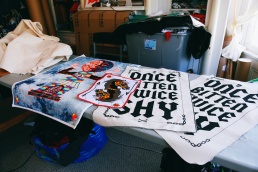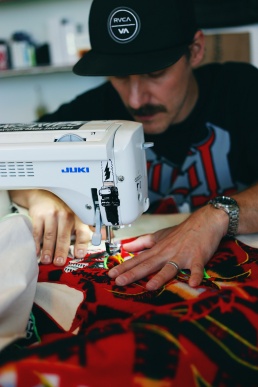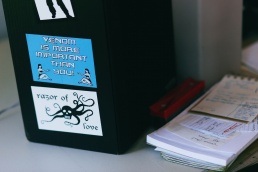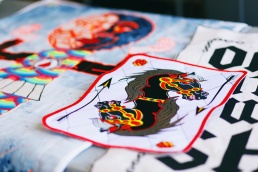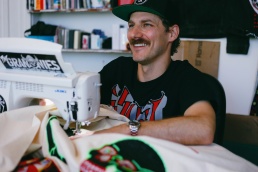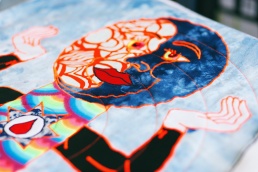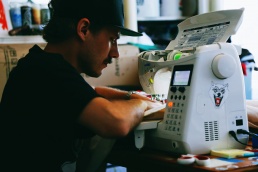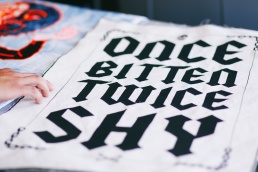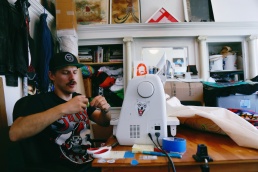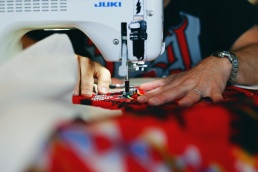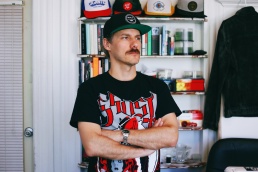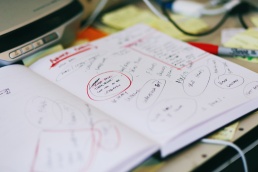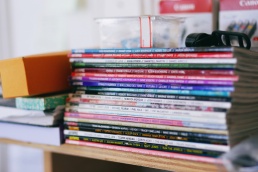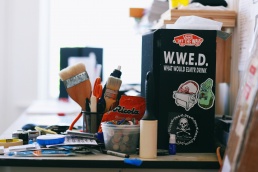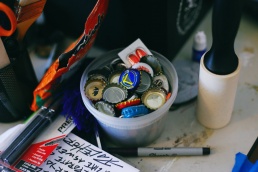This is Ben Venom
Quilts.
I don’t know much about quilts. All I know is that they are either a bed accessory or an alternative for comforters during the winter season. I often associate it with retired grandmothers, like a sisterhood, who meets up and sew quilts. Maybe it’s Winona’s fault, you know from that ‘90s chick-flick, “How to Make an American Quilt”. (In my defense, I have not seen the movie entirely but captured the gist of it). But surely, however, after meeting Ben Venom, every bit of perception about this misconceptualized textile changed.
On a recent trip to San Francisco, I’ve arranged a meeting with Ben for a studio visit and possibly an interview. I’m delighted that he accepted. We arrived at Ben’s studio at two on a Saturday afternoon. It was at the heart of Haight-Ashbury. An old neighborhood known to be where the hippie counterculture began. Tourists of every kind, everywhere. They surge through the streets like it was in Hollywood Boulevard but smaller and less energetic. There were bars of different kinds. And, of course it wouldn’t be Haight-Ashbury without naked hippies riding their bicycles, cruising the street back and forth with their butt flashing.
Upon our arrival, Ben showed us inside his studio on the third flood of an apartment building. Where we were introduced to Ted, his cat, found lying on a pile of textile scraps on the floor. Ben Venom is a Swiss German Georgia-born San Francisco based quilter, a husband, a professor who will change the way I see quilts.
Interview by Mark Changco.
Photos by Maria Noble.
Tell me how did you get into quilting?
From an early age I always wanted to do something art-related so I was always drawing and painting. I moved into textile-based work around 2008 and prior to doing that, I was doing a lot of printmaking like screen printing and painting. I hit a point in my art career where I had a little bit of crisis of conscience. I wanted to do something that can go beyond just being a pretty picture on a wall, I wanted art that can go a multitude of things. So, textile has enabled me to do that, where I’m really interested in this idea of art and functionality. Now, my art is not just art but it’s also functional and that’s really important to me.
All that came about when my good friend Kevin Earl Taylor curated a group show in Berlin at Neurotitan Gallery. I wanted to do something really big for that show so I decided to make a quilt. I bought a book called Quilting Basics 101. I taught myself how to make a quilt; made a quilt out of all my heavy metal band t-shirts and then I just kinda progress. Since then all of my work has been primarily textile-based.
What were your inspirations when you were a child?
I grew up in Atlanta and when I was a child I was inspired on punk rock album covers, skateboard graphics, heavy metal, logos, graphics, skateboard decks, t-shirt print designs, tattoo culture anything remotely close to that was a big inspiration to me and it still is to this day. So all that I still look at on a regular basis.
How did your name “Venom” come about?
I’m a product of the Atlanta punk rock scene of the 90’s and a lot of people that I knew back then had nicknames. And you know how nicknames are? It’s like it’s not really something you come up with yourself it’s something that’s… more often than not given to you and it usually just kinda sticks, you know? And it’s something you can’t get rid of.
Luckily for me, everyone called me “Ben Venom”. It could’ve been a lot worse. At least it wasn’t like “Ben Waterproof” or something stupid.
When I was younger, I had a short-temper and “venom” just kinda parlayed into that quite well. I was always known as Ben Venom since I was a teenager and it just obviously stuck up until now. My real last name is Baumgartner and people can’t really spell that correctly so venom is a little bit easier to spell. (laughing)
What made you decide to move to San Francisco especially here in Haight-Ashbury district?
I’ve lived in San Francisco for over twelve years, I moved out here in 2004 to go to the San Francisco Art Institute for my graduate degree. I graduated with my masters in 2007 and then stayed. And now, I am visiting faculty at the San Francisco Art Institute. So, it’s kinda come full circle a little bit, I was then a student, now I’m faculty. I call the shots.
“Luckily for me, everyone called me “Ben Venom”. It could’ve been a lot worse. At least it wasn’t like “Ben Waterproof” or something stupid.”
Do you think living in Atlanta influenced your work?
Yeah, absolutely! I’m always been of the opinion that as an artist you can’t not help but be influenced by your environment so I was definitely influenced from where I grew up — the southeastern part of the United States — and I’m definitely influenced where my wife and I live now which is the Haight-Ashbury.
I’m a block from the Grateful Dead House, Charles Manson lived two blocks down the street you know that idea of the counter-culture movement, lots of free-flowing ideas from the sixties that are still around to this day. San Francisco is very left-leaning, we’re very progressive, and where I’m from in Georgia specifically Marietta. That’s been labeled as one of the more conservative county in the United States. So if you think about where I grew up, being in a very conservative county, then moved in a very progressive city, I can’t help but be influenced by that. Like the Hell’s Angels, they ride down our street anytime they do a run. My wife found out the reason why they do that it’s because they’re honoring a former H. A. member who used to live on our street and so they honor him by coming down our street and then they’d turn left on Haight and head down towards the park every time they do a major run. It’s interesting! Obviously that plays a role within my work. In the past, I’ve done a lot of battle jackets. They’re influenced by motorcycle clubs but also punk rock and heavy metal jackets where you’d put patches. They’re all hand sewn and what not.
Where I grew up in Georgia, I never saw a motorcycle club ever. There’s no motorcycle club that will roll by the house where I grew up in cause it was the suburbs. But when I came out to California, I’ve seen the Hell’s Angels are all-around and few other smaller clubs. They are prevalent over in Oakland and few surrounding the bay area.
“A lot of the bands I listened to growing up, a lot of them were in skateboard videos. The 411 videos always had a lot of good music in ‘em.”
You’re a fan of Punk Rock and Heavy Metal. Who’s your favorite band and what is your favorite album? Why?
Ah! That’s a terribly tough question to answer! Um, I don’t know as far as bands go I’ll just name a few ‘cause I know that’s kind of a little bit of a cop-out but it’s hard to give one, I mean you gotta cut me a little slack, right? (laughing)
So, one of my all time favorite bands is Fugazi from Washington DC. Huge fan of them, I saw them play a couple of times back in the 90’s. Iron Maiden, Black Sabbath, seen both of them play as well, not necessarily Black Sabbath but like without Ozzy, so it was like Dio was with them so they call themselves Heaven and Hell but it’s basically Sabbath. My wife and I just saw the band Ghost. I’m wearing the t-shirt, they just played here last week and they were awesome.
And for your album?
I really like Tommy Guerrero’s “A Little Bit of Somethin”. I’ve listened to that a bunch. You know he grew up skateboarding Powell Peralta? Search for “Animal Chin” video. He lives out here, I’ve seen him out and about a couple of times walking on the street with his guitar on his back, very nice guy. (I introduced myself briefly one time, he’s super nice.) Basically anything Tommy Guerrero, he’s got a couple of albums out but yeah, “A Little Bit of Somethin” is a good one. Margarette Kilgallen did the cover art for that one, I believe.
A lot of the bands I listened to growing up, a lot of them were in skateboard videos. The 411 videos always had a lot of good music in ‘em. TransAM was in that and there was a period there for a year or two like every 411 that came out or any skate video that came out around that time — in the mid-90’s — had a song from TransAM’s album either “Surrender to the night” or “The Surveillance” there were two albums from TransAM that were used a lot in skateboard videos.
Another album would be “Sabbath Bloody Sabbath”. “Somewhere in Time” by Iron Maiden is another good one. I can’t name one by Fugazi man, like c’mon I can’t pick one!
In a recent tv interview you described your work as a collision comparing it with the hadron collider in Geneva.
Well, it was little scary, you know? They thought it was gonna become the end of the world.
It’s where they discovered the Higgs.
Yeah, so, we’re basically shooting particles at near light-speed at each other, then they would hit and they’re there looking at what kind of reaction would take place.
And, that’s what they call God’s particle.
Right. Which is really pretty crazy stuff. And then, last time I was reading up on it they still hadn’t really operated it at like full throttle.
So, basically they can make life?
Well, I think you can make that argument. It just goes to how much philosophy do you really want to go into, you know what I mean? It’s like, its really merging. It’s theology, philosophy and science. It’s a weird mix of things. Depending on where you’re coming from.
What’s even scarier is that they can create, like, a black hole. And then if that would be the case then it will just engulf our entire universe. How can you contain or control it? We don’t really know much of it at all. So people there were really concerned about that happening.
“I’m taking all these kind of disparate elements, ideas and cultures and colliding them together in a form of a piece of artwork…”
But yeah, I describe my art in one word. My art is a collision. It’s a collision of fine art, craft, and what I would call the Fringes of Society. And what that refers to is: punk rock, heavy metal, skateboarding, motorcycle clubs, tattoo culture, paganism, the occult mysticism, etc., and I take all these different ideas and I collide them together in a form of a functional piece of artwork. And, that’s where the collision comes from.
And, I do talk a lot about the Hadron Collider in Switzerland because that’s exactly what they’re doing — they’re colliding particles together in near light-speed. And what I’m doing — not near light-speed obviously — is I’m taking all these kind of disparate elements, ideas and cultures and colliding them together in a form of a piece of artwork, which is not really different in what they’re doing.
Do you think art should be functional?
For me, it is important that it is. And this is me speaking from my personal point-of-view as an artist. It’s important that my art also has that dimension where it’s not just something that can only be viewed visually. It’s something that can be tactile. It can be used beyond being seen in a fine art museum or a gallery — you can actually use it.
And it gives yet another layer to the work. I focus on the concept, the aesthetics, and then also the functionality. It’s able to encompass a lot of different realms where it’s not just one thing. Let’s say you come into a gallery, and you see my work, and you appreciate it hopefully from an aesthetic standpoint and hopefully appreciate it from a conceptual level. But even if you can’t appreciate it from neither of those, to a level that’s ok, cause it still serves as a distinct purpose in the world because technically speaking they are all quilts. So, if hell would’ve freeze over, you can keep warm with one of my quilts.
“I don’t want to do the same piece every time. I’m continually trying to push myself to do something different… trying to push myself where I don’t always want to do just this.”
Tell me about your first quilt for your first show in Berlin. What was it like?
Yeah, the first quilt I’ve ever made was in 2008 for a show that Kevin Earl Taylor curated in Berlin. The quilt that I made, roughly, was six feet by eight feet and it was primarily made from a lot of my old heavy metal band t-shirts that I have lying around.
So, you’ve known Kevin from before?
I’ve known Kevin for a long time. He’s also a southerner. Yeah, he lives out here. But he’s from Charleston, South Carolina I’m from Atlanta, Georgia we met many years ago.
How was your very first art show like?
The first legit art show ever that I had was at a coffee shop in Atlanta, Georgia.
Was it quilts?
No, it was like mixed media cyanotypes.
What’s a Cyanotype?
A cyanotype is a very basic photographic process where it’s kind of like a blueprint. It’s been around for a long time. They’re all small, and they’re mixed media cyanotypes. I did a cyanotype and then I would sew on to it by hand or watercolor it or paint on top of it. And, I think that show was probably around 2000 or 2001. It was a sold out show which I’ve yet to replicate (laughing). It’s like the worse way to start out cause you cannot get to do that, right? Start it big and just have gone downhill since then.
“A big concept behind the work is this idea of upcycling and recycling and using donated fabrics to become the foundation to the work.”
How do you pick your textiles?
A lot of the fabric is donated and/or recycled. The way I look at the work is that it’s not just mine, it’s ours! A big concept behind the work is this idea of upcycling and recycling and using donated fabrics to become the foundation to the work. All the stuff you see here and all these bins, this stuff the fabric that people have given me: t-shirts, denim, scraps of fabric, leather, or whatever else I take all that, cut that up and then turn that into the quilts.
One way to look at my work, basically it’s everyone’s unexplained stain, tear or rip on-view in the form of a piece of an artwork. So, it’s not just mine, it’s ours. For example, if you’re to donate that piece of RVCA t-shirt to me, then a piece of you would be in the work because you wore that shirt. Maybe you had a very interesting life experience with it and you remember when that interaction happened you were wearing that shirt but yet, at some point in the life of that shirt you can’t wear it anymore, maybe it doesn’t fit or maybe it’s just too threadbare so you give it to me, I cut it up, use it in a form of a piece of an artwork — now a piece of you is in the work. And that to me is important cause it’s all of ours now, it’s everyone’s personal memories sewn together.
Walk me through your process when you start on an artwork.
All artwork starts from doing research on a particular interest you may have. I have a lot of different interest so researching these different interests, like, being online, reading, watching movies, listening to podcasts, going to shows, music or art shows, and then coming back with all these material floating around in my head… I then start working on my sketchbook, then taking the ideas from the sketchbook moving it into the computer, refining the design, scaling it to whatever size I want it to be and then making templates off of that. Then I will take these templates and I will go through the mess of fabrics everywhere, pick and choose which fabric would look good within the design.
One way to look at the work that I do is that it’s just a very complicated puzzle. And so this particular piece of fabric, which might be a t-shirt or a piece of a leather jacket, would fit good in this design but then, a piece of denim might fit good in this part of the design. Then the interlocking pieces of the puzzle kind of come together to form the over-all design. One large top-layer in each little piece that’s different fabric, is sewn on which we call appliqué.
“I’ve had all kinds of jobs. I worked at Blockbuster Video at one point and that job sucked; I worked at PetSmart in high school, that was crappy, literally crappy cause I have to clean up dog crap.”
What were your previous jobs before? Perhaps a job you hated?
I’ve had all kinds of jobs. I worked at Blockbuster Video at one point and that job sucked. It doesn’t even exist anymore. I worked at PetSmart in high school, that was crappy, literally crappy cause I have to clean up dog crap. I worked at a grocery store. Let’s see what else. (laughing) I worked at some horrible tile company doing graphic design, that was horrendous, and yeah, I don’t know, I could go on and on.
I’ve had a lot of jobs. And I still have a job. I’m currently visiting faculty at the San Francisco Art Institute, I like that job, though. I’ve taught for many years. I’ve taught workshops all-around the US, too. I’ve taught at other institutions but the last couple of years I’m just teaching at the San Francisco Art Institute.
Then I have another part-time job. You know I’ve done custom picture framing for years and years and years. I like those jobs.
What was the biggest risk you’ve taken so far?
Well, one of the more recent bigger risk is going from a few years back when I just literally, one day, switching from doing mixed media screen prints and the next day only doing textiles. That was a pretty large leap for anyone I think — I mean totally switching your entire artistic practice overnight. And that’s basically what I did.
But as far as risk-taking goes… absolutely! I don’t want to do the same piece every time. You know I’m continually trying to push myself to do something different: different materials, different types of designs, different types of functional items — which could be jackets, pillows, quilts, patches — so that’s all moving in a different direction and trying to push myself where I don’t always want to do just this. Because for me, in order to do what I do, I don’t want to get bored by it. I want to keep myself involved and interested. So, if I’m not interested in what I’m doing, then why should anyone be interested in it? I’ve always been of the opinion as an artist that, I stand 110% behind the work that I do. And I feel that the audience will be able to see that within the work. I don’t want to do something that is half-assed or that looks like shit because when that goes out there, that is a representation of me and I always want to be represented in the best light possible. I want it to be the best representation of me always.
“I don’t want to do something that is half-assed or that looks like shit because when that goes out there, that is a representation of me and I always want to be represented in the best light possible.”
In order to succeed in life sometimes you have to fail. That kind of goes back into your question about risk-taking. Failure and mistakes are part of it. But those are not going to happen until you take risks.
Tell me that moment when you decided to take this route.
As I was working on that first quilt that I made back in ’08. At the time, I was really into this type of work that I was doing. And it’s fresh and I’m still learning. I am by no means any type of master sewer or master textile artist. There are many different tricks that I have yet to learn and that’s one of the things that kept me interested in doing textiles. It’s something that has always tried to push me and learn something new.
At best, I would describe myself as maybe a top-seated amateur. But by no means, professional in any capacity at all. And that kinda speaks to a larger point, whereas, I never let my lack of knowledge of something hinder me from taking my idea all the way through.
Where do you think art is headed?
Art in general? Man, I don’t know, that’s a pretty broad tough question. Uhh, where is art headed?
I guess I can say that technology is making a more of a segway into art making obviously like new technologies artist would clearly want to use the new technologies to express themselves in different ways. Case and point, virtual reality, um, when my wife and I was in Berlin last year, the Berlin Biennial had a VR piece, which was really interesting, and I see that happening more now so I would make the argument you’d probably see more of that in the future within art. Oh, I don’t know how you wouldn’t. As technology gets more advanced, and artists get to use that particular technology, that is clearly going to reflect the current art making practice of that time. So, as virtual reality becomes more available to artist like you and I, then yeah, we would be able to access it more and that would clearly segway into what we’re doing.
“… I never let my lack of knowledge of something hinder me from taking my idea all the way through.”
What advice can you give a young artist?
Well, I give a lot of advice (laughing). But one thing I would say, is that, you basically, just have to keep pushing yourself and not give up. The majority of artist that are successful, that I know personally, got to that level because they just never stopped doing it. There’s no hidden trick or anything it’s just that they never gave up. After all these years, they always kept pushing themselves all the time and they never slowed down, 110% everyday, year after year always putting yourself out there, working, working, working, working… and then working again… and then working a little bit more. So, pushing, pushing, pushing and then ultimately that leads to progression and that’s how they got to where they are. They earned it. And so, if you want it, you gotta earn it and that’s what I would say: stay motivated and keep pushing yourself and don’t give up. It’s so easy to get discouraged but everyone feels discouraged including myself and I think once you fully understand that and realize that then you’re able to work within your own kind of discouragement and push pass that and stay motivated and keep working.
Are you satisfied creatively?
Never satisfied. Never satisfied. Never satisfied. Always, always pushing.
Right now I want to learn more about leather making. I want to learn about making clothes in particular, uh, those are the two big ones right now. I have a book on leather that my brother-in-law bought me recently, I want to learn more about that. And that would probably segway slowly into my work. Now, I’m already using leather but more kind of actual leather making.
But yeah, I’m never satisfied.
What’s next for you?
Coming up, I have some work that will be at the Taubman Museum next month. After that I will have a piece at the Gregg Museum in North Carolina. Uh, I have a solo show at the Tarble Arts Center at Eastern Illinois University in August. I’m organizing New Wave Exhibition at the Red Bull House of Art in Detroit, MI and the show is all centered around the theme of fine art craft, so I think I got about eleven artists in the show all primarily craft based. That opens I think in late September. And then, after that, actually next week, I have a piece in a group show at Helium Cowboy which is in Hamburg, Germany. I believe Jaybo is in that show also. Then, a bunch of stuff in 2018.
Are you selling your jackets online?
Well, all of my works are for sale, you can find them on artsy. Go to artsy.com and then type in Ben Venom. I primarily work with galleries from all over. If someone is interested in purchasing work from me, they can just email me directly and my email is on my website it’s just benvenom.com then I can put them in contact with the appropriate gallery depending on what particular piece they wanted, but Artsy has a lot of work that is available. You can always contact me directly and put you in touch with a particular gallery.
